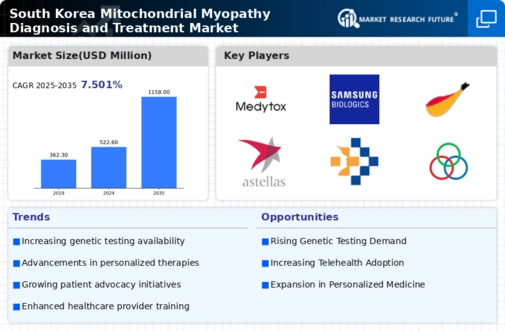Growing Patient Advocacy and Awareness
The rise of patient advocacy groups and increased public awareness regarding mitochondrial disorders are driving factors in the mitochondrial myopathy-diagnosis-treatment market. Organizations dedicated to educating patients and healthcare professionals about these conditions are emerging in South Korea, leading to heightened awareness and understanding. This advocacy is crucial for promoting early diagnosis and treatment, which can significantly improve patient quality of life. As more individuals become informed about mitochondrial myopathy, the demand for specialized diagnostic and treatment options is likely to increase, thereby propelling market growth. The influence of these advocacy groups may also lead to more comprehensive healthcare policies.
Emerging Therapeutic Options and Research
The development of novel therapeutic options is a significant driver for the mitochondrial myopathy-diagnosis-treatment market. Ongoing research into gene therapy, enzyme replacement therapy, and other innovative treatments is gaining momentum in South Korea. Clinical trials are underway, exploring the efficacy of these new therapies, which could potentially transform the treatment landscape for mitochondrial disorders. The market is expected to see a surge in investment, with estimates suggesting that the therapeutic segment could grow by over 30% in the next five years. As new treatments become available, healthcare providers will likely seek to incorporate these options into their practice, further stimulating market growth.
Government Support and Funding Initiatives
Government support and funding initiatives play a pivotal role in shaping the mitochondrial myopathy-diagnosis-treatment market. In South Korea, the government has implemented various programs aimed at increasing research funding for rare diseases, including mitochondrial disorders. This financial backing is essential for fostering innovation in treatment options and improving diagnostic methodologies. For instance, the South Korean government allocated approximately $50 million in 2025 for research into rare genetic disorders, which is expected to benefit the mitochondrial myopathy-diagnosis-treatment market. Such initiatives not only enhance research capabilities but also encourage collaboration between academic institutions and the pharmaceutical industry.
Rising Prevalence of Mitochondrial Disorders
The increasing incidence of mitochondrial disorders in South Korea is a crucial driver for the mitochondrial myopathy-diagnosis-treatment market. Recent studies indicate that mitochondrial myopathy affects approximately 1 in 5,000 individuals, leading to a growing demand for effective diagnostic and therapeutic solutions. As awareness of these conditions rises, healthcare providers are more likely to seek advanced diagnostic tools and treatment options. This trend is further supported by the South Korean government's initiatives to enhance healthcare access and funding for rare diseases, which could potentially increase market growth. The focus on early diagnosis and personalized treatment plans is likely to drive innovation in the mitochondrial myopathy-diagnosis-treatment market.
Technological Advancements in Diagnostic Tools
Technological innovations in diagnostic tools are significantly impacting the mitochondrial myopathy-diagnosis-treatment market. The introduction of next-generation sequencing (NGS) and advanced imaging techniques has improved the accuracy and speed of diagnosing mitochondrial disorders. In South Korea, the adoption of these technologies is expected to grow, with the market for genetic testing projected to reach approximately $200 million by 2026. Enhanced diagnostic capabilities not only facilitate early detection but also enable tailored treatment approaches, thereby improving patient outcomes. As healthcare providers increasingly rely on sophisticated diagnostic tools, the mitochondrial myopathy-diagnosis-treatment market is likely to experience substantial growth.























Leave a Comment